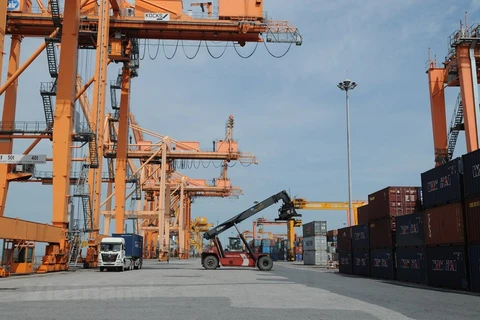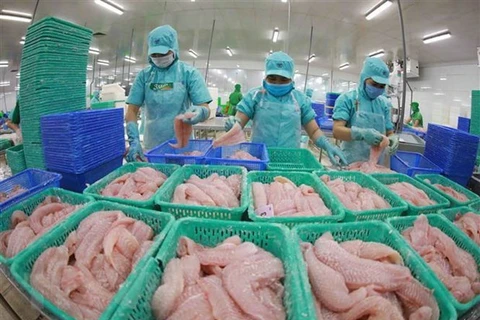 Experts at the seminar entitled “Developing Vietnamese brands in the CPTPP markets” hosted by Cong Thuong (Industry and Trade) magazine (Photo: VietnamPlus)
Experts at the seminar entitled “Developing Vietnamese brands in the CPTPP markets” hosted by Cong Thuong (Industry and Trade) magazine (Photo: VietnamPlus) Hanoi (VNA) – Nearly five years after the Comprehensive and Progressive Agreement for Trans-Pacific Partnership (CPTPP) took effect, the quantity and value of exports to these markets have increased but the image of Vietnamese brands remains modest, heard a seminar hosted by the Cong Thuong (Industry and Trade) magazine on September 27
Ngo Chung Khanh, Deputy Director of the Multilateral Trade Policy Department under the Ministry of Industry and Trade (MoIT), said Vietnam has enjoyed stable growth in its exports to Canada and Mexico since the CPTPP agreement took effect in January 2019, even during the COVID-19 pandemic or amidst geopolitical fluctuations in the world.
Additionally, Vietnam’s trade surplus with the two markets usually accounts for one-third to half of the combined trade surplus with countries, Khanh stressed.
According to Trade Counselor Tran Thu Quynh from the Vietnam Trade Office in Canada, the North American country is now one of Vietnam's 10 most important trading partners globally.
According to data from the Canadian government, including transshipment through the US, Vietnam's exports to Canada in 2022 increased by 26.4% in trade value compared to 2021.
Notably, five years after the implementation of the CPTPP, Vietnam's exports to Canada rose to 9.9 billion USD in 2022 from 4.1 billion USD in 2018.
Quynh said CPTPP serves as a lever to encourage businesses from both countries to pay more attention to each other's product structures and markets. It also helps promote the further development of supply chains, and transportation and logistics services between Vietnam and Canada.
However, the utilisation of preferential tariffs under the CPTPP still remains low, participants said.
Khanh pointed out ample room to promote exports to Canada, Mexico and Peru, citing that some Vietnamese products account for only about 3-5% of the market share.
Currently, many consumers in these markets are aware of certain Vietnamese brands, such as rice and coffee, but they are only familiar with specific brands, he said.
Vietnamese brands have not yet made significant appearances on supermarket shelves or in the minds of consumers in the CPTPP countries, especially in new markets, he continued.
Khanh attributed it to the fact that many businesses still hesitate to build brands and some don’t have enough financial and human resources as well as experience to create branded products.
Currently, Vietnamese businesses primarily export raw materials or processed products so their added value and their brands remain modest.
Trinh Huyen Mai, Deputy Head of the Trade Promotion Sub-department under the Trade Promotion Agency (Ministry of Industry and Trade), said about 95% of Vietnam’s exports in the industrial sectors are products from foreign-invested firms with their own brands.
To build brands and export under their own brand, businesses should increase the value of their products through quality improvement and product diversification to suit the target market, she said.
 In addition to investing in a systematic brand strategy and periodic communication plans, businesses need to pay heed to registering and protecting intellectual property rights for their branded products in foreign markets, according to a representative of the Trade Promotion Agency. (Photo: VNA)
In addition to investing in a systematic brand strategy and periodic communication plans, businesses need to pay heed to registering and protecting intellectual property rights for their branded products in foreign markets, according to a representative of the Trade Promotion Agency. (Photo: VNA) It is necessary for enterprises to actively participate in trade promotion activities organised by ministries, sectors, and associations, Mai said, they should take advantage of the national and industry brands when entering new markets.
In addition to investing in a systematic brand strategy and periodic communication plans, according to Mai, businesses need to pay heed to registering and protecting intellectual property rights for their branded products in foreign markets.
Nguyen Thi Huyen, General Director of Vietnam Staraniseed Cassia Manufacturing and Exporting JSC, recalled that when the company took part in some international fairs in 2007, most customers didn’t know that Vietnam had cinnamon, anise, or other Vietnamese spices and these products didn’t have any competitive advantage compared to the same types in other markets.
That’s the reason why the company determined to build a really good product, thereby affirming Vietnamese brand on the world market, she said./.

























